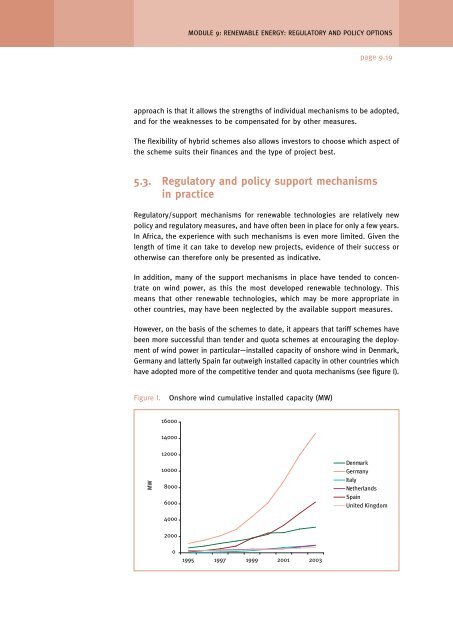Regulatory and policy options to encourage development of ...
Regulatory and policy options to encourage development of ...
Regulatory and policy options to encourage development of ...
- No tags were found...
You also want an ePaper? Increase the reach of your titles
YUMPU automatically turns print PDFs into web optimized ePapers that Google loves.
MODULE 9: RENEWABLE ENERGY: REGULATORY AND POLICY OPTIONSpage 9.19approach is that it allows the strengths <strong>of</strong> individual mechanisms <strong>to</strong> be adopted,<strong>and</strong> for the weaknesses <strong>to</strong> be compensated for by other measures.The flexibility <strong>of</strong> hybrid schemes also allows inves<strong>to</strong>rs <strong>to</strong> choose which aspect <strong>of</strong>the scheme suits their finances <strong>and</strong> the type <strong>of</strong> project best.5.3. <strong>Regula<strong>to</strong>ry</strong> <strong>and</strong> <strong>policy</strong> support mechanismsin practice<strong>Regula<strong>to</strong>ry</strong>/support mechanisms for renewable technologies are relatively new<strong>policy</strong> <strong>and</strong> regula<strong>to</strong>ry measures, <strong>and</strong> have <strong>of</strong>ten been in place for only a few years.In Africa, the experience with such mechanisms is even more limited. Given thelength <strong>of</strong> time it can take <strong>to</strong> develop new projects, evidence <strong>of</strong> their success orotherwise can therefore only be presented as indicative.In addition, many <strong>of</strong> the support mechanisms in place have tended <strong>to</strong> concentrateon wind power, as this the most developed renewable technology. Thismeans that other renewable technologies, which may be more appropriate inother countries, may have been neglected by the available support measures.However, on the basis <strong>of</strong> the schemes <strong>to</strong> date, it appears that tariff schemes havebeen more successful than tender <strong>and</strong> quota schemes at encouraging the deploymen<strong>to</strong>f wind power in particular—installed capacity <strong>of</strong> onshore wind in Denmark,Germany <strong>and</strong> latterly Spain far outweigh installed capacity in other countries whichhave adopted more <strong>of</strong> the competitive tender <strong>and</strong> quota mechanisms (see figure I).Figure I.Onshore wind cumulative installed capacity (MW)1600014000MW1200010000800060004000DenmarkGermanyItalyNetherl<strong>and</strong>sSpainUnited Kingdom200001995 1997 1999 2001 2003










